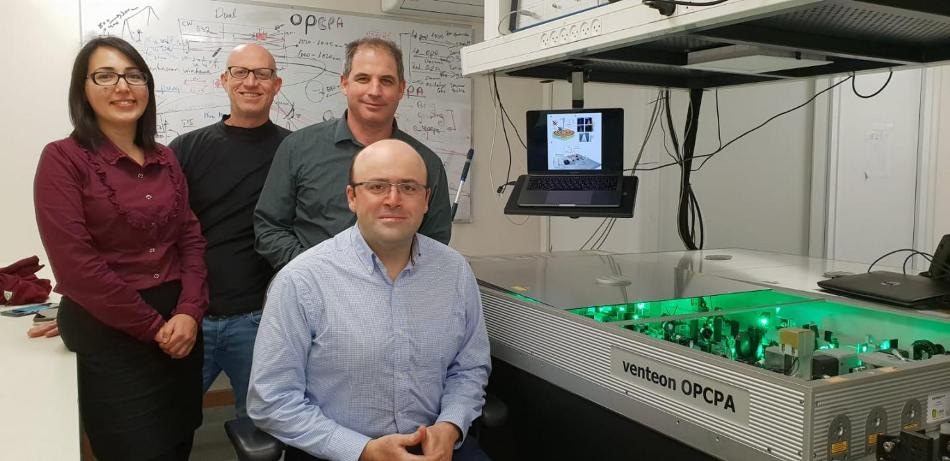Feb 20 2019
Excitons, which are electrically neutral quasiparticles, possess exceptional properties and occur only in insulating and semiconducting materials. They can be accessed easily in two-dimensional (2D) materials with a thickness of just a few atoms, such as molybdenite and carbon.
 Standing left to right: Dr Lena Yadgarov, Dr Assaf Levanon, Dr Haim Suchowski; sitting: Dr Michael Mrejen. (Image credit: American Friends of Tel Aviv University)
Standing left to right: Dr Lena Yadgarov, Dr Assaf Levanon, Dr Haim Suchowski; sitting: Dr Michael Mrejen. (Image credit: American Friends of Tel Aviv University)
Upon combining these 2D materials, they demonstrate quantum properties that are possessed by neither material on its own.
A new study performed at the Tel Aviv University investigates the production and propagation of excitons in 2D materials in an unparalleled small time frame and at an exceptionally high spatial resolution. The study was headed by Professor Haim Suchowski and Dr Michael Mrejen of TAU’s Raymond & Beverly Sackler Faculty of Exact Sciences and reported in Science Advances on February 1st, 2019.
Quantum mechanics—a fundamental physics theory—describes nature at the tiniest energy scales. “Our new imaging technology captures the movement of excitons in a short time frame and at nanometer scale,” stated Dr Mrejen. “This tool can be extremely useful for peeking into a material’s response at the very first moments light has affected it.”
Such materials can be used to significantly slow down light to manipulate it or even store it, which are highly sought-after capabilities for communications and for photonics-based quantum computers. From the instrument capability point of view, this tour de force opens up new opportunities to visualize and manipulate the ultrafast response of many other material systems in other spectrum regimes, such as the mid-infrared range in which many molecules are found to vibrate.
Haim Suchowski, Professor, Raymond & Beverly Sackler Faculty of Exact Sciences, Tel Aviv University.
The researchers created a specialized spatiotemporal imaging method at the femtosecond-nanometric scale and witnessed the exciton-polariton dynamics in tungsten diselenide, a semiconductor material, at ambient temperature.
The exciton-polariton is a quantum entity produced as a result of the coupling of light and matter. As the material under study was specific, the measured propagation speed was nearly 1% of the speed of light. At such a time scale, light can travel only a few hundred nanometers.
We knew we had a unique characterization tool and that these 2D materials were good candidates to explore interesting behavior at the ultrafast-ultrasmall intersection. I should add that the material, tungsten diselenide, is extremely interesting from an applications point of view. It sustains such light-matter coupled states in very confined dimensions, down to single atom thickness, at room temperature and in the visible spectral range.
Dr Michael Mrejen, Raymond & Beverly Sackler Faculty of Exact Sciences, Tel Aviv University.
Currently, the researchers are looking for means to control the velocity of semiconductor waves by, for instance, combining several 2D materials in stacks.